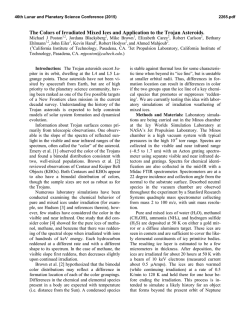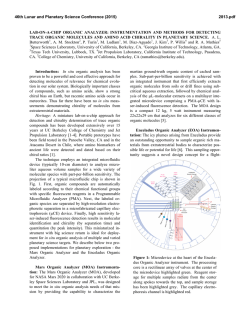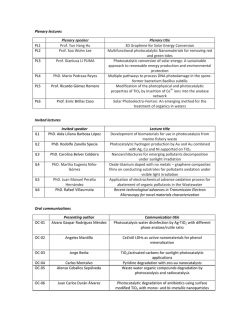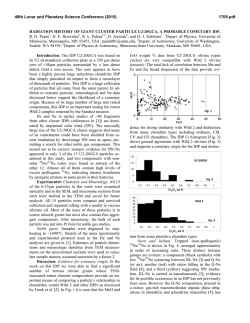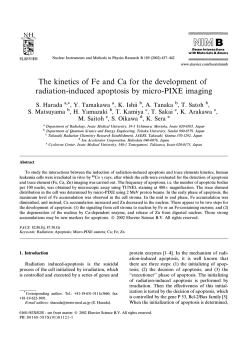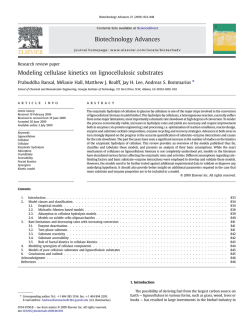
A Model Study
Decontamination of Industrial Waste Water by Photocatalytic Oxidation of Organic Components: A Model Study By Frank Sabin, Thomas Türk, and Arnd Vogler* Industrial waste water which was highly loaded by chlorinated (50 mg A O X l " ) and other organic compounds was decontaminated by laboratory-scale photooxidation of these organic impurities in the presence of oxygen and titanium dioxide as photocatalyst. The disappearance of the organic compounds was determined as a function of the irradiation time. Some contaminants such as chlorobenzene, trichloroethylene and trichloromethane were photolyzed separately in order to obtain information on the course and stoichiometry of the photooxidation. Reinigung von Industrieabwasser durch photokatalytische Oxidation der organischen Verbindungen (Modell- 1 Introduction benzene, trichloroethylene and trichloromethane in separate experiments. The consumption of the reactants as well as the formation of C O was determined as function of the irradiation time. 1 The removal of chlorinated organic compounds from waste water is a difficult problem because these substances are not accessible to conventional decontamination procedures. The photooxidation by oxygen with semiconductor materials such as T i 0 as photocatalyst seems to be a promising method to effectively remove organic impurities from waste water. Previous studies have shown that a variety of organic compounds including chlorinated materials can be photooxidized in water on a laboratory scale [1 —8]. In some cases it was demonstrated that the photomineralization to H 0 , C 0 and H C l was complete [1, 3, 9 - 1 2 ] . Presently, attempts are being made to extent this process from a laboratory to a technical scale [13 — 15]. Generally the photocatalytic oxidation has been studied for model solutions which contain only a single organic compound while industrial waste water which may contain a wide variety of organic pollutants has not been subjected to this photocatalysis. In the present investigation we studied the applicability of this method to the purification of industrial waste water. The efficiency was evaluated by a kinetic analysis. The consumption of the organic compounds was determined as a function of the irradiation time. Since a complete analysis of all organic compounds was not available their concentration was determined by the group parameter T O C (total organic carbon). Larger organic molecules are certainly not photooxidized in one step. Accordingly, intermediates which could be even more toxic than the original contaminant may be generated during the photooxidation. Unfortunately, in the majority of previous studies the photooxidation was monitored only by the disappearance of the substrate. However, an additional time dependent analysis of the products would provide valuable information on the course and stoichiometry of the photolysis. According to these considerations we studied the photooxidation of the contaminants chlorobenzene, 2 2 2 * D r . F . Sabin, D r . T h . T ü r k , Prof. D r . A . Vogler, Institut für A n organische C h e m i e der U n i v e r s i t ä t Regensburg, U n i v e r s i t ä t s s t r a ß e 31, 8400 Regensburg studie). Industrieabwasser, das mit chlorierten (50 mg A O X 1 ') und anderen organischen Verbindungen hoch belastet war, wurde durch Photooxidation im Labormaßstab in Gegenwart von Sauerstoff und Titandioxid als Photokatalysator gereinigt. Die Abnahme der organischen Verbindungen wurde als Funktion der Belichtungszeit bestimmt. E i nige Schadstoffe wie Chlorbenzol, Trichlorethylen und Trichlormethan wurden einzeln photolysiert, um Informationen über den Ablauf und die Stöchiometrie der Photooxidationen zu erhalten. : 2 Experimental Section Materials and Reagents: The photocatalyst T i O P-25 was used as supplied by Degussa. This material was mainly anatase. The BET-surface was 55 + 15 m g" according to the supplier. The average particle size was 30 nm. Doubly distilled water was chosen as general solvent. The industrial waste water was supplied by Wacker-Chemie G m b H , Burghausen. Samples were collected from the feed of the sewage treatment plant (waste water A) and from waste water which came from the production of silicones (waste water B). Waste water A contained pollutants from the production of polymers (Polyvinylchloride and polyvinylacetate), chlorinated solvents and silicones. Chlorinated organic components were essential constituents of all waste water samples [16]. The concentration of some selected compounds and group parameters are given in Table 1. All samples were deep-frozen immediately after being collected to avoid loss of contaminants by evaporation and chemical reaction prior to photolysis. Chlorobenzene (p.a.), trichloroethylene (p.a.) and benzene (p.a.) were supplied by Merck, trichloromethane (99%) was supplied by Aldrich. All substrates were used without further purification. Photolysis: As photolysis cell Perkin-Elmer HS-6 round vessels (length 3.7 cm, diameter 2 cm) were used which could be sealed gas tight with a septum. The cell transmitted light above 320 nm. The photolysis cell contained 2 ml of sample solution, 2.0 mg T i O and a small stirrer. For the photolysis of chlorobenzene, benzene, trichloroethylene and trichloromethane in separate experiments the concentrations of the aqueous solutions were 1.0 m M . Irradiation of all samples was carried out in a Photon Technology International setup equipped with a 450 W Xenon lamp (Osram). The light beam was focused on the photolysis cell by an elliptic mirror. Z. Wasser- Abwasser-Forsch. 25, 163-167 (1992) < V C H Verlagsgesellschaft mbH, D-6940 Weinheim, 1992 : : 1 : 0044-3727 92 0307-0163 S 03.50+.25 0 163 The p H of the industrial waste water samples was adjusted to 8 by adding N a O H before irradiation. Due to the limited supply of oxygen in the sealed photolysis cells the concentrations of organic material were generally adjusted to the amount of available oxygen [17] in order to achieve complete photooxidation. Solutions of chlorobenzene, benzene, trichloroethylene and trichloromethane were left at their natural pH. All samples were vigorously stirred during photooxidation (Ika Combimag R C T magnetic stirrer, 1100 r.p.m.) to keep the catalyst suspended and to achieve a sufficient transfer of oxygen from the gas to the liquid phase. All photolyses were carried out three times. Blank solutions were kept in the dark for comparison. Photooxidation rates were reproducible to within ± 5 % . Analyses: Carbon dioxide produced during the photolyses was measured by head-space gas chromatography (PerkinElmer gas Chromatograph 8500 equipped with a HS-6 headspace analyzer, hot-wire detector, a packed column (2 m, 1/8 in. diameter, Porapak Q, 100—120 mesh) and helium as carrier gas). The gas chromatographic measurements were calibrated by the reaction of N a C 0 with H C l . The T O C of the waste water samples was determined as C 0 by G C after oxidation of all organic components by K S 0 (90 C, 120 min). The loss of T O C during the photolysis was calculated from the amount of C 0 generated photochemically. Aqueous solutions of chlorobenzene, benzene, trichloroethylene and trichloromethane which were photolyzed in separate experiments were also analyzed by G C as described elsewhere [18]. The oxygen consumption during photooxidation was measured gas chromatograpically (Perkin Elmer gas Chromatograph as described above with packed column 2 m, 1/8 in. diameter, molecular sieve 5Ä, 60 — 80 mesh). For calibration the initial concentration of oxygen in the aqueous solution was taken from literature data [17]. 2 strate is high. Therefore the efficiency of the photooxidation is limited by the number of catalytic sites available. This results in a zeroth-order kinetics. At lower concentration of substrate however, the degradation is proportional to the concentration. The reaction is now limited by diffusion to the semiconductor surface. This may result in a pseudo firstorder kinetics. These predictions were indeed confirmed experimentally. The decrease of substrate has been found to follow pseudofirst order kinetics if substrate concentration was low [11, 12, 18, 21, 23, 26, 2 8 - 3 0 , 32, 33]. On the contrary, at high concentrations a zeroth-order kinetics was observed [18, 31, 33]. However, any simple kinetic model can not take into account special effects such as the competition of different substrates for the catalytic sites [10, 31]. In addition, an insufficient and declining oxygen supply causes complications which can be encountered in closed systems as used in our experiments. 3 2 2 2 8 2 0 20 40 60 80 irradiation time (min) 1 3 Results and Discussion Figure 1: P h o t o o x i d a t i o n of waste water A with 563 m g T O C l " ( A ) , waste water A (1:10) with 52 m g T O C 1 ~ ( • ) and waste water B (1:10) with 100 m g T O C T (•) 1 1 General: The photocatalytic oxidation of a wide variety of organic compounds in aqueous solution has been reported. The irradiation of the suspended powder of the semiconductor such as T i 0 (k < 390 nm [19]) leads to the separation of electrons and holes. Both are capable to react with species adsorbed onto the surface of the semiconductor particles. While electrons may reduce adsorbed oxygen to O f the hole can oxidize adsorbed water or hydroxide ions to O H ' radicals. These hydroxyl radicals are powerful oxidants which are able to oxidize many substrates at the semiconductor surface [3, 7, 8, 20 — 23]. It has been shown that organic compounds such as chlorocarbons are completely photomineralized according to the overall stoichiometry (1) [1, 3, 1 0 - 1 2 , 2 4 - 2 6 ] : 2 0 hv C H Cl + x0 n m y 2 >nC0 + y H C l + w H 0 2 2 40 60 80 100 120 irradiation time (min) (1) The time dependent turnover can be determined by measuring the decrease of the substrates [18, 27, 28] and/or the increase of products [3, 5, 18, 24]. From these data the efficiency and the course of the photolysis can be evaluated on the basis of a suitable kinetic analysis. For the heterogeneous photocatalysis with semiconductor particles several approaches have been applied. The Langmuir-Hinshelwood kinetics [1, 3, 8, 10, 21, 25, 2 8 - 3 1 ] provides a general model which is applicable to a large concentration range. According to this model all reactive catalytic sites of the seminconductor surface are occupied when the concentration of sub- 20 Figure 2: P h o t o o x i d a t i o n of waste water A (1:10) with 52 m g T O C 1 1 Industrial Waste Water: At high substrate concentrations a plot turnover versus irradiation time should result in a straight line in accord with a zeroth-order kinetics. At later stages of the photolysis a curve should be observed since the substrate concentration has reached the range of pseudofirst order kinetics. Finally, the concentration approaches a limiting value which may correspond to 100% turnover. Such a characteristic behavior was not observed for waste water A (Fig. 1) since the amount of oxygen in the sealed photolysis cell was insufficient for a complete photooxidation [17]. However, when waste water A was diluted 1:10 the oxygen supply was sufficient and the plot showed the expected behavior (Fig. 1, 2). Similar results were obtained with diluted waste water B (Fig. 1, 3). dized with sufficiently different efficiencies. Even after an irradiation of 180 min the photooxidation of the organic constituents of diluted waste water B was not yet complete (83%). Selected Chlorinated Organic Compounds: In the previous section it has been demonstrated that mixtures of chlorinated organic compounds can be photooxidized efficiently although it is difficult to gain a deeper insight in the course of the photolysis under these conditions. More details are revealed if single compounds instead of mixtures are photooxidized. We explored this possibility and selected typical chlorinated organic compounds for this purpose. In addition to the disappearance of the substrate the formation of C O as photooxidation product was determined in order to detect the generation of intermediates and to analyze the stoichiometry of the photolyses. For the photolysis of chlorobenzene the decrease of this substrate did not match the C O production during the first 100 min of irradiation (Fig. 4). An explanation for this observation is provided in Fig. 5. In addition to the decrease of the substrate the difference between this decrease and the increase of stoichiometric amounts of C O was plotted versus irradiation time. This difference gives evidence for the formation of intermediates which are generated from the beginning, reach a maximum concentration after 10 min, undergo themselves a photooxidation and are completely photooxidized at the end (120 min). It is quite understandable that larger molecules such as chlorobenzene are not photooxidized in one step. : : 0 20 40 60 80 100 120 irradiation time (min) Figure 3: P h o t o o x i d a t i o n of waste water B (1:10) with 100 mg T O C 1 r Table 1: A n a l y t i c a l characterization of waste water samples [16] : C o n t a m i n a n t [mg 1 '] Waste Water A Waste Water B Chlorobenzene 1,1 -Dichloroethylene trans 1,2-Dichlorocthylcnc eis 1.2-Dichloroethylene Trichloroethylene Tetrachloroethylenc Chloromethane Chloroethanc Dichloromethane Trichloromethane Tetrachloromcthane AOX POX TOC COD pH <0.1 <0.1 <().! <0.1 <0.1 <0.1 2.4 2.5 4.6 0.3 <0.1 0.5 <0.1 <().! <0.1 <().l <().! 13 11 2.6 <0.1 <0.1 44.3 6.2 563 1352 4.6 55.0 22 2 1020 2539 1.2 0 20 40 60 80 100 irradiation time (min) Figure 4: P h o t o o x i d a t i o n of chlorobenzene calculated by decrease in substrate ( • ) and increase in C O ( • ) : A O X : adsorbablc organic halides; P O X : purgcablc organic halidcs: T O C : total organic c a r b o n : C O D : chemical oxygen demand The inspection of Fig. 2 and 3 reveals more details. The organic constituents of diluted waste water A were almost completely photooxidized after an irradiation of 60 min (Fig. 2). After 120 min a limiting value of 92% photooxidation was reached. The residual T O C may be due to compounds such as perchlorinated alkanes (Table 1) which are photooxidized very slowly or not at all [1, 18]. Diluted waste water B showed an additional deviation (Fig. 3). Two ranges of zeroth-order behavior can be identified. The first of this region extends from 0 to about 20 min and the second from about 70 to 120 min. In the beginning an efficient photolysis took place which was almost complete after 45 min irradiation time. At later stages a less efficient photolysis occurred. Both ranges can be assigned most likely to two different compounds or groups of compounds which are photooxi- 0 10 20 30 40 50 60 70 80 90 irradiation time (min) Figure 5: P h o t o o x i d a t i o n of chlorobenzene calculated by decrease in substrate ( • ) and intermediates d u r i n g photorcaction (•) Although benzene was not a component of the industrial waste water (see above) it was included in the present work in order to compare it with chlorobenzene. It can be concluded from Fig. 6 that in the beginning both photolyses proceed with comparable rates while at later stages the photooxidation of chlorobenzene is less efficient. It is apparently the intermediate which is responsible for this delay (Fig. 6). 0 10 20 30 40 50 irradiation time (min) Figure 6: P h o t o o x i d a t i o n of benzene calculated by decrease in substrate ( • ) and intermediates d u r i n g photoreaction (•) Although we made no attempt to analyze the intermediates other investigators identified some primary photooxidation products of aromatic compounds. For example, phenol and quinone were formed as intermediates of the photooxidation of benzene [10]. Hydroxylated aromatic compounds were also detected during the photooxidation of substituted aromatics [8, 11, 21, 23, 25, 26, 31]. On the basis of our results we can conclude that in the initial attack of O H " radicals there is some discrimination between chlorobenzene and benzene. However, at later stages the disruption of the carbon-chlorine bonds of chlorobenzene is apparently less facile than the photooxidative breakage of carbon-hydrogen bonds. While trichloroethylene displays a similar reactivity as chlorobenzene or benzene (Fig. 7) the photooxidation of trichloromethane occurs in one step since no intermediates were detected in the latter case. At any time of the photolysis the decrease of substrate matched the stoichiometric formation of C O . For trichloroethylene the aldehyde CI3CCHO was identified as intermediate of the photooxidation [30]. : 0 10 20 30 40 50 60 irradiation time (min) Figure 7: P h o t o o x i d a t i o n of trichloroethylene calculated by decrease of substrate ( • ) and intermediates d u r i n g photoreaction (•) T a b l e 2: E x p e r i m e n t a l and theoretical equivalents for the oxygen c o n s u m p t i o n and c a r b o n dioxide p r o d u c t i o n a c c o r d i n g to equation (1) at complete p h o t o o x i d a t i o n O x y g e n equivalents C O equivalents E x p e r i m e n t a l T h e o r e t i - Experimental T h e o r e t i cal cal : Substrate Chlorobenzene 6.0 ± 1 . 0 7.0 5.7 + 0.3 6.0 Trichloroethylene 1.6±0.7 1.5 2.1 ± 0 . 2 2.0 Trichloromethane 0.5 + 0.3 0.5 1.1 ± 0 . 2 1.0 Benzene 6.4+1.1 7.5 6.0 ± 0 . 3 6.0 A complete photooxidation of chlorobenzene, benzene, trichloroethylene and trichloromethane was confirmed. At the end of the photolysis the consumption of substrate and oxygen matched the formation of C O i according to equation (1) (Table 2). 4 Conclusion Although more studies are necessary to fully understand the photocatalytic oxidation of organic compounds including chlorinated hydrocarbons a technical application of this method for the decontamination of waste water seems feasible. Acknowledgement We thank the Wacker-Chemie G m b H , Burghausen for supply of waste water and Dr. I. Bauer and J. Lenz for help and discussion. Financial support by the Bundesminister für Forschung und Technologie ( B M F T 02-WA 8615) is gratefully acknowledged. We thank the Degussa A G , Frankfurt for providing titanium dioxide P-25. Literature [1] Ollis, D. F., Pelizzeti, £., and Serpone, N.: Heterogeneous P h o tocatalysis in the E n v i r o n m e n t : A p p l i c a t i o n to Water Purification. In: Serpone, N . and Pelizzetti, E . (eds.): Photocatalysis Fundamentals and A p p l i c a t i o n . Wiley, N e w Y o r k 1989, 603 — 607, and references cited therein. [2] Matthews, R. W.: E n v i r o n m e n t : P h o t o c h e m i c a l and P h o t o catalytic Processes. Degradation of O r g a n i c C o m p o u n d s . In: Pelizzetti, E . and Schiavello, M . (eds.): P h o t o c h e m i c a l C o n version and Storage of Solar Energy. K l u w e r A c a d e m i c P u b lishers, D o r d r e c h t 1990, 4 2 7 - 4 5 0 . [3] Matthews, R. W.: K i n e t i c s of Photocatalytic O x i d a t i o n of O r ganic Solutes over T i t a n i u m D i o x i d e . J o u r n a l of Catalysis / / / , 2 6 4 - 2 7 2 (1988). [4] Pelizzetti, E., Borgarello, M., Minero, C, Pramauro, E., Borgarello, E., and Serpone, N.: Photocatalytic Degradation of P o l y c h l o r i n a t e d D i o x i n s and P o l y c h l o r i n a t e d Biphenyls in A q u e o u s Suspensions of Semiconductors Irradiated with S i m ulated Solar Light. Chemosphere / 7 , 4 9 9 - 5 1 0 (1988). [5] Grätzel, C. K., Jirousek, M., and Grätzel, M.: D e c o m p o s i t i o n of O r g a n o p h o s p h o r o u s C o m p o u n d s on Photoactivated T i 0 Surfaces. J o u r n a l of M o l e c u l a r Catalysis 60, 3 7 5 - 3 8 7 (1990). [6] Pelizzetti, £., Maurino, V., Minero, C, Carlin, V., Pramauro, £., Zerbinati, O., and Tosato, M.: Photocatalytic Degradation of Atrazine and O t h e r s-Triazine Herbicides. E n v i r o n m e n t a l Science and Technology 24, 1 5 5 9 - 1 5 6 5 (1990). [7] Pelizzetti, E., Carlin, V., Minero, C, and Grätzel, M.: Enhancement of the Rate of Photocatalytic Degradation on T i 0 of 2C h l o r o p h e n o l , 2 , 7 - D i c h l o r o d i b e n z o d i o x i n and A t r a z i n e by Inorganic O x i d i z i n g Species. N e w J o u r n a l of C h e m i s t r y 15, 351 - 3 5 9 (1991). [8] Terzian, R., Serpone, N., Minero, C, and Pelizzetti, E. J.: P h o tocatalyzed M i n e r a l i s a t i o n of Cresols in A q u e o u s M e d i a with Irradiated T i t a n i a . J o u r n a l of Catalysis 128, 3 5 2 - 3 6 5 (1991). [9] Barbeni, M., Pramauro, £., Pelizzetti, £., Borgarello, £., and Serpone, N.: Photodegradation of Pentachlorophenol C a t a lyzed by Semiconductor Particles. Chemosphere 14, 195 — 208 (1985). [10] Turchi, C. S. and Ollis, D. F: M i x e d Reactant Photocatalysis: Intermediates and M u t u a l Rate Inhibition. J o u r n a l of C a t a l ysis 119, 4 8 3 - 4 9 6 (1989). [11] D'Oliveira, J.-C, Al-Sayed, G., and Pichat, P.: Photodegradation of 2- and 3 - C h l o r o p h e n o l in T i 0 A q u e o u s Suspensions. E n v i r o n m e n t a l Science and Technology 24, 990 — 996 (1990). [12] Tseng, J. M. and Huang, C. P.: R e m o v a l of C h l o r o p h e n o l s from Water by P h o t o c a t a l y t i c O x i d a t i o n . Water Science and Technology 23, 3 7 7 - 3 8 7 (1991). [13] Matthews, R. W.: A n A d s o r p t i o n Water Purifier with in Situ Photocatalytic Regeneration. J o u r n a l of Catalysis 113, 5 4 9 - 5 5 5 (1988). [14] Tyner, C. £ . : A p p l i c a t i o n of Solar T h e r m a l Technology to the Destruction of H a z a r d o u s Wastes. Solar Energy M a t e r i a l s 21, 1 1 3 - 1 2 9 (1990). [15] Pacheo, J., Prairie, M., Evans, L., and Yellowhorse, L.: E n g i neering-Scale Experiments of Solar Photocatalytic O x i d a t i o n of Trichloroethylene. Proceedings of the Intersociety Energy C o n v e r s i o n Engineering Conference 25, 141 — 145 (1990). [16] Bauer, I. and Lenz, J.: W a c k e r - C h e m i e G m b H , Burghausen, private c o m m u n i c a t i o n . [17] a) In a H S - 6 vessel 6.6 x 1 0 m o l 0 [17b — e] were available. T h e oxygen demand of 2 m l of undiluted waste water A was 8.5 x 10 m o l 0 and of undiluted waste water B 1.6 x 10 m o l 0 (calculated by the C O D , Table 1). — b) Montgomery, H. A. C, Thorn, N. S., and Cockburn, A. J.: D e t e r m i n a t i o n of 2 2 2 - 5 2 5 4 2 2 Dissolved O x y g e n by the W i n k l e r M e t h o d and the Solubility of O x y g e n in Pure Water and Sea Water. J o u r n a l of A p p l i e d Chemistry 14, 2 8 0 - 2 9 5 (1964). - c) Benson, B. B. and Krause, D.: The C o n c e n t r a t i o n and Isotopic F r a c t i o n a t i o n of Gases Dissolved in Freshwater in E q u i l i b r i u m with the Atmosphere. L i m n o l o g y and Oceanography 25, 6 6 2 - 6 7 1 (1980). - d) Water Q u a l i t y , Determination of Dissolved O x y g e n , Electrochemical Probe M e t h o d . I S O / D I S 5814 (1982). e) B e s t i m m u n g des in Wasser g e l ö s t e n Sauerstoffes mittels membranbedeckter Sauerstoffsonde. D I N 38408-G 22 (1986). [18] Sabin, F., Türk, T, and Vogler, A.: P h o t o o x i d a t i o n of O r g a n i c C o m p o u n d s in the Presence of T i t a n i u m D i o x i d e : Determination of Efficiency. J o u r n a l of Photochemistry and P h o t o biology, A : Chemistry, 63, 9 9 - 1 0 6 (1992). [19] Fox, M. A.: O r g a n i c Heterogeneous Photocatalysis: C h e m i c a l Conversions Sensitized by Irradiated Semiconductors. A c counts of C h e m i c a l Research 16, 3 1 4 - 3 2 1 (1983). [20] Cunningham, J. and Srijaranai, S.: Isotope-Effect Evidence for H y d r o x y l R a d i c a l Involvement in A l c o h o l P h o t o - o x i d a t i o n Sensitized by T i 0 in Aqueous Suspensions. J o u r n a l of P h o tochemistry and P h o t o b i o l o g y , A : Chemistry 43, 329 — 335 (1988). [21] Augugliaro, V., Palmisano, L., Schiavello, M., Sclafani, A., Marchese, L., Martra, G., and Miano, F: Photocatalytic D e g radation of N i t r o p h e n o l s in A q u e o u s T i t a n i u m D i o x i d e D i s persions. A p p l i e d Catalysis 69, 3 2 3 - 3 4 0 (1991). [22] Kormann, C, Bahnemann, D. W., and Hoffmann, M. R.: P h o tolysis of C h l o r o f o r m and O t h e r O r g a n i c Molecules in A q u e ous T i 0 Suspensions. E n i v r o n m e n t a l Science and Technology 25, 4 9 4 - 5 0 0 (1991). [23] Minero, C, Aliberti, C, Pelizzetti, £., Terzian, R., and Serpone, N.: K i n e t i c Studies in Heterogeneous Photocatalysis. 6. A M I Simulated Sunlight Photodegradation over T i t a n i a in Aqueous M e d i a : A First Case of F l u o r i n a t e d A r o m a t i c s and Identification of Intermediates. L a n g m u i r 7, 928 — 936 (1991). [24] Matthews, R. W.: Photocatalytic O x i d a t i o n of Chlorobenzene in A q u e o u s Suspensions of T i t a n i u m D i o x i d e . J o u r n a l of C a talysis 97, 5 6 5 - 5 6 8 (1986). [25] Ollis, D. F, Hsiao, C.-H., Budiman, L., and Lee, C.-H.: Heterogeneous Photoassisted Catalysis: Conversions of P e r c h l o r o ethylene, Dichloroethane, C h l o r o a c e t i c A c i d s and C h l o r o b e n zenes. J o u r n a l of Catalysis 88, 8 9 - 9 6 (1984). [26] Augugliaro, V., Palmisano, L., Sclafani, A., Minero, C, and Pelizzetti, £ . : Photocatalytic D e g r a d a t i o n of P h e n o l in A q u e o u s T i t a n i u m D i o x i d e Dispersions. Toxicological and E n v i r o n mental C h e m i s t r y 16, 8 9 - 1 0 9 (1988). [27] Hisanaga, T, Harada, K., and Tanaka, K.: Photocatalytic D e g radation of O r g a n o c h l o r i n e C o m p o u n d s in Suspended T i 0 . J o u r n a l of Photochemistry and P h o t o b i o l o g y , A : C h e m i s t r y 54, 1 1 3 - 1 1 8 (1990). [28] Al-Ekabi, H. and Serpone, N.: K i n e t i c Studies in Heterogeneous Photocatalysis. 1. Photocatalytic Degradation of C h l o r i nated Phenols in Aerated A q u e o u s Solutions over T i 0 Supported on a G l a s s M a t r i x . J o u r n a l of P h y s i c a l C h e m i s t r y 92, 5 7 2 6 - 5 7 3 1 (1988). [29] Hsiao, C.-Y., Lee, C.-L., and Ollis, D. F: Heterogeneous P h o tocatalysis: D e g r a d a t i o n of D i l u t e Solutions of C H C 1 , C H C 1 and C C 1 with Illuminated T i 0 . J o u r n a l of Catalysis 82, 4 1 8 - 4 2 3 (1983). [30] Pruden, A. L. and Ollis, D. F: Photoassisted Heterogeneous Catalysis: The D e g r a d a t i o n of Trichloroethylene in Water. J o u r n a l of Catalysis 82, 4 0 4 - 4 1 7 (1983). [31] Al-Ekabi, H., Serpone, N., Pelizzetti, E., Minero, C, Fox, M. A., and Draper, R. B.: K i n e t i c Studies in Heterogeneous P h o tocatalysis. 2. T i 0 - M e d i a t e d D e g r a d a t i o n of 4 - C h l o r o p h e n o l A l o n e and in a Three C o m p o n e n t M i x t u r e of 4 - C h l o r o p h e n o l , 2 , 4 - D i c h l o r o p h e n o l , and 2,4,5-Trichlorophenol in A i r - E q u i l i brated A q u e o u s M e d i a . L a n g m u i r 5, 250 — 255 (1989). [32] Pruden, A. L. and Ollis, D. F: D e g r a d a t i o n of C h l o r o f o r m by Photoassisted Heterogeneous Catalysis in D i l u t e A q u e o u s Suspensions of T i t a n i u m D i o x i d e . E n v i r o n m e n t a l Science and Technology 17, 6 2 8 - 6 3 1 (1983). [33] Matthews, R. W.: Purification of Water with Near-V.V. Illuminated Suspensions of T i t a n i u m D i o x i d e . Water Research 24, 6 5 3 - 6 6 0 (1990). 2 2 2 2 2 4 2 2 2 3
© Copyright 2025


